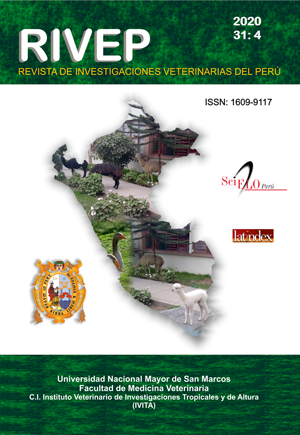Effect of the supplementation of multi-nutritional blocks with agro-industrial by-products on the production and quality of milk of criollo cows at grazing in San Martín, Peru
DOI:
https://doi.org/10.15381/rivep.v31i4.19029Keywords:
animal feeding, coconut by-products, rice by-products, tropicsAbstract
The effect of multinutritional blocks (BMN) based on agro-industrial residues on the production and composition of bovine milk in a tropical region of Peru was evaluated. For the elaboration of the BMN, agro-industrial residues from the processing of rice (rice polishing) and coconut (cake) were used. Twelve native cows were used to graze in paddocks with Brachiaria brizantha distributed in two groups (A and B) of six animals during two periods of 21 days each. Two treatments were established: T0 (grazing without supplementation) and T1 (grazing plus supplementation with BMN). During the first period, group A received T1 and group B received T0, while in the second period the reverse was done. Daily milk production (kg/day), milk composition (protein, fat, lactose, total solids, %) and the level of urea in milk (mg/100 ml) were measured. The change-over design was used to analyze the results (α=0.05). There were no significant differences in milk production between treatments (T0: 4.0 kg/day; T1: 4.1 kg/day). In the composition of milk, the level of protein and lactose were significantly higher in T1 than in T0 (p<0.05), but similar with respect to urea in milk and total solids. The low BMN consumption (346 g/day/cow) may explain the lack of response to supplementation.
Downloads
Downloads
Published
Issue
Section
License
Copyright (c) 2020 David Godoy Padilla, Fredy Puémape Dávila, Roberto Roque Alcarraz, Melisa Fernández Curi, Jorge Vargas Morán, Segundo Gamarra Carrillo, Víctor Hidalgo Lozano, Carlos Gómez Bravo

This work is licensed under a Creative Commons Attribution-NonCommercial-ShareAlike 4.0 International License.
AUTHORS RETAIN THEIR RIGHTS:
a. Authors retain their trade mark rights and patent, and also on any process or procedure described in the article.
b. Authors retain their right to share, copy, distribute, perform and publicly communicate their article (eg, to place their article in an institutional repository or publish it in a book), with an acknowledgment of its initial publication in the Revista de Investigaciones Veterinarias del Perú (RIVEP).
c. Authors retain theirs right to make a subsequent publication of their work, to use the article or any part thereof (eg a compilation of his papers, lecture notes, thesis, or a book), always indicating the source of publication (the originator of the work, journal, volume, number and date).



